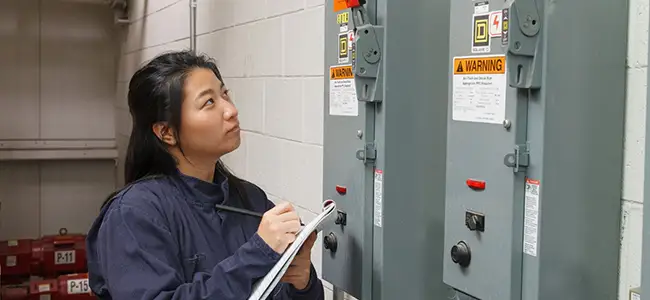Labels for Safety, Visuals and Facility ID Desktop Printers
Labels for Product, Wire and Lab ID Benchtop Printers
Labels for Safety, Visuals and Facility ID Desktop Printers
Labels for Product, Wire and Lab ID Benchtop Printers
Safety and Facility ID Desktop Printers
Product, Wire and Lab ID Benchtop Printers
Barcode Scanner and Printer Kits
Barcode Scanner and Printer Kits
PaintStripe Floor Marking Stencils
Valve Lockouts & Hose Lockouts
Group Lock Boxes & Permit Control
Pipe Marker Accessories & Mounting Brackets
Maintenance and Production Tags
Calculators and Assessment Tools
Product Finders and Data Sheets
Electrical panel clearance is a critical aspect of workplace safety, ensuring that electrical equipment is accessible and maintainable without risk of injury. Proper clearance prevents hazards such as electric shock, fires, and equipment damage, contributing to a safer working environment.
The Occupational Safety and Health Administration (OSHA) sets stringent standards for electrical panel clearance to protect workers. Compliance with these standards is crucial in preventing accidents and maintaining a safe workspace. OSHA's guidelines ensure that all electrical panels have sufficient space around them for safe operation and maintenance, reducing the likelihood of accidents and promoting overall workplace safety.

OSHA, the Occupational Safety and Health Administration, is a regulatory body responsible for ensuring safe and healthy working conditions for employees. Its mission is to set and enforce standards, provide training, outreach, education, and assistance to achieve safer workplaces.
OSHA and the National Electrical Code (NEC) specify that electrical panels must have a minimum clearance of 36 inches in depth, 30 inches in width, and 78 inches in height. These dimensions ensure sufficient space for workers to safely and efficiently perform maintenance tasks. Additionally, maintaining these clearances is crucial for preventing arc flash incidents and aligns with the 2024 NFPA 70E arc flash labeling requirements.
OSHA and the National Electrical Code (NEC) specify the minimum clearance distances required around electrical panels. These include a depth of 36 inches, a width of 30 inches, and a height of 78 inches. These dimensions ensure adequate space for workers to perform maintenance tasks safely and efficiently.
Providing diagrams and images can significantly enhance understanding of clearance requirements. Visual guides can illustrate the necessary distances and help ensure that all employees are aware of the proper clearance specifications, thus promoting compliance and workplace safety.
By adhering to these detailed specifications and understanding the importance of proper electrical panel clearance, businesses can ensure a safer environment for their employees and avoid the legal and safety ramifications of non-compliance.

Proper clearance around electrical panels is essential for preventing accidents and ensuring safe maintenance. Adequate space reduces the risk of electric shock, fire, and other hazards, allowing workers to perform their tasks safely.
Non-compliance with OSHA regulations can lead to severe legal consequences, including fines and penalties. Companies may also face increased liability in the event of an accident. Ensuring compliance not only protects employees but also safeguards the organization from legal and financial repercussions.
By addressing these common issues and implementing practical measures, businesses can stay compliant with OSHA regulations and ensure a safer workplace.
By following these best practices, businesses can ensure the proper installation and maintenance of electrical panels, contributing to a safer and more compliant workplace environment. Regular adherence to these guidelines helps prevent accidents and ensures the longevity and efficiency of electrical systems.

By following this comprehensive guide, businesses can better understand the importance of OSHA electrical panel clearance requirements, ensuring a safer and more compliant workplace.
undefined
OSHA compliance essentials include hazard communication, lockout/tagout procedures, personal protective equipment, and emergency planning, emphasizing the role of labeling and signage in workplace safety.
Ensure Workplace Safety
Arc flash labeling requirements per the 2024 NFPA 70E standard include necessary elements like warning signs, hazard categories, and specific PPE guidelines to ensure safety and compliance in workplaces.
Discover Arc Flash Requirements
Arc flash is a hazardous electrical event caused by energy release from faults, leading to severe injuries. The page discusses causes, effects, and prevention, including proper labeling, protective gear, and safety training.
Learn About Arc Flash